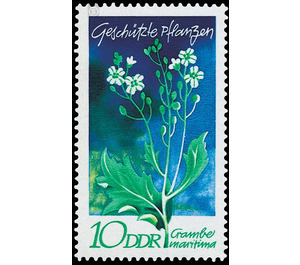Protected native plants - Germany / German Democratic Republic 1970 - 10 Pfennig
Theme: Flora
| Country | Germany / German Democratic Republic |
| Issue Date | 1970 |
| Face Value | 10.00 |
| Color | multi-colored green |
| Perforation | K 14 |
| Printing Type | Photogravure |
| Stamp Type | Postage stamp |
| Item Type | Stamp |
| Chronological Issue Number | 1305 |
| Chronological Chapter | GER-DDR |
| SID | 545004 |
| In 28 Wishlists | |
Protected Plants The Ministry of Posts and Telecommunications of the German Democratic Republic issues six multicolored special postage stamps with the depictions of protected plants, Crambe maritima L. (10 pfennig value). The cabbage belongs to the family of cruciferous plants (Brassicaceae). It is characterized by cabbage-like, coarse, somewhat pudgy pear-blue frosted leaves and honey-scented white flowers. His pods are like stemmed bullets. As a genuine salt plant (holophyte), it only occurs on the Baltic coast, where it always thrives in the vicinity of the beach in the area of saline groundwater. The plants usually grow in the gaps between coarser blocks. Its distribution is limited to the Atlantic coasts of Europe from Spain to the Baltic Sea. In the GDR he rarely appears on the Baltic coast between Wismar and Rügen.


